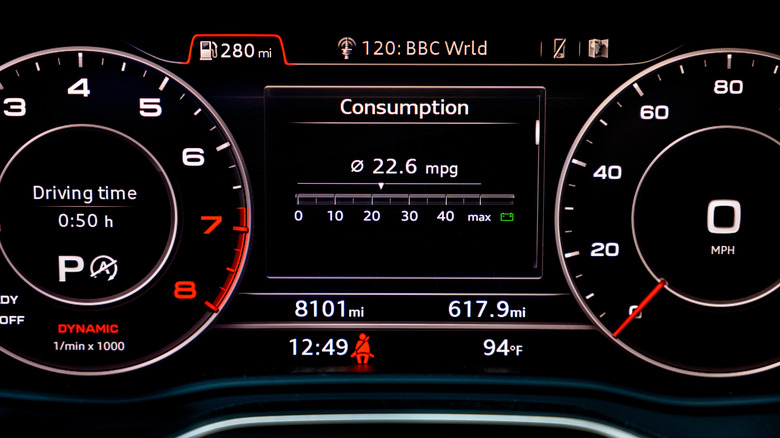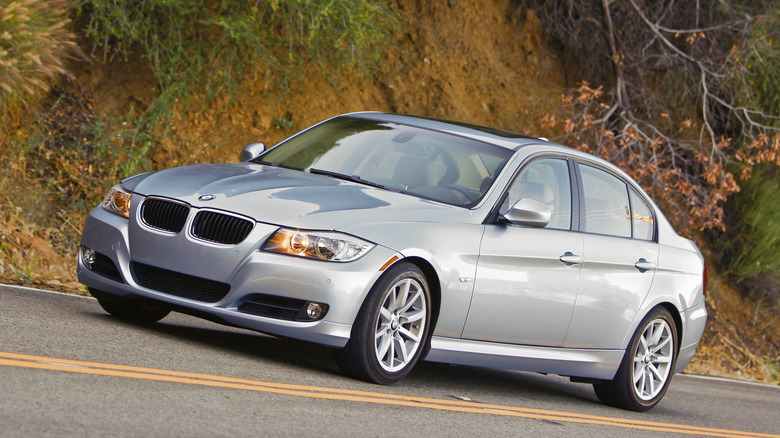
Miles per gallon (MPG) is well-established as the standard measure of fuel economy. It's so well established, in fact, that few of us question the MPG rating on a daily basis — at least until we notice we're heading back to the gas station a little more often than we imagined.
So how is that even possible? Well, for starters, there is no better measure of fuel economy than actually operating a car. So when drivers start noticing a discrepancy with stated MPG ratings, there's reason to question how those ratings are determined. That's why understanding how the EPA tests for fuel economy is important not just for knowing if the Monroney window sticker on a new car is accurate, but also whether that used car you're considering will last all week on a tank of gas.
The reality is that every driver is different, and driving behaviors have a big impact on fuel economy. Do you punch it at every intersection? First of all, that's a fun way to drive, and second, that will undoubtedly impact your fuel economy. As will driving with the AC on at all times, or even braking too much. As you'll see, the Environmental Protection Agency uses a handful of "scenarios" to test for fuel economy, but keep in mind that your mileage will vary — quite literally, in this case.
 michelmond/Shutterstock
michelmond/Shutterstock
Before explaining how MPG testing works, it's important to understand why we even use miles per gallon as a measure of fuel economy in the first place. There are certainly other metrics we could use, such as fuel consumption per tank instead of per gallon. However, miles per gallon is a simple equation. If you drive 100 miles on five gallons of gas, then the MPG rating is 20 miles per gallon. At a basic level, it's a good measure of what to expect. While it all depends on how you drive and where, MPG is a good starting point.
Using miles per gallon as a measure of fuel economy started as a result of the oil crisis under the Nixon and Ford presidencies in the 1970s, which led to the creation of the Corporate Average Fuel Economy (CAFE) standard. CAFE was the true harbinger for MPG ratings because it meant automakers were required by law to provide MPG estimates on new cars. Fast forward to 2008 and the EPA decided to split fuel economy into three ratings: city driving, highway driving, and a combined metric of both. This has become the industry standard.
Right away, you can see why MPG rating might not match what you experience. Driving primarily in the city means you will likely never hit the combined rating — which includes highway — as it will be lower. Drive on the highway most of the time and your MPG might be more accurate to the rating.
 Kevin Carter/Getty Images
Kevin Carter/Getty Images
Now that we have a standard measure of fuel economy, we can gauge not just the environmental impact of vehicles but also the cost to own them. After all, MPG is really an indicator of both — you'll burn both gas and cash when you drive. That sweet new-to-you 2023 BMW M3 has an environmental and financial impact, so MPG helps you measure both. The fact that the MPG rating is included on the sticker and is often displayed prominently at an automaker's website is a testament to how much we rely on the rating.
A good question to ask at this point is who determines what the MPG rating is? That's where the Environmental Protection Agency is so important, but a common misunderstanding is that EPA is solely responsible for the test results.
The EPA sets the guidelines for testing and oversees the process. The agency also performs vehicle testing at the National Vehicle and Fuel Emissions Laboratory in Ann Arbor, Michigan. However, automakers also submit their own test results. Where the EPA becomes a critical part of the process is in outing automakers who fudge the numbers, as we saw when the Hyundai fuel economy scandal was made public in 2012.
The easiest way to get a rough estimate of your own MPG starts with filling up your tank to as close to total tank capacity as the pump's automatic shut off system will allow. For example, on the 2010 BMW 3 I own, the tank capacity is 16.1 gallons. The next step is to drive the car as long as possible before you need a refill while tracking the total miles driven. So, let's say you drive 350 miles. You can calculate your own MPG by taking the total miles driven divided by the tank capacity. In this case, it was 21.7 MPG, which is slightly less than the combined EPA estimate for this model.
That actually gives you a pretty good idea of how MPG is calculated. It's a measure of how many miles you can drive by the gallon, and it can be used for comparing the fuel economy of two vehicles you might be considering. The 2010 BMW 3 that gets roughly 21.7 miles per gallon (based on my personal testing) is not as fuel efficient as a 2025 Kia Soul, which is rated at 31 miles per gallon combined by the EPA.
To review — MPG is a good measure of fuel economy, the EPA does the gatekeeping but automakers also do their own tests, and it's ultimately a simple calculation of how many miles you can drive on one gallon of gas. You can also calculate the MPG yourself, but things start to get more complicated as far as official MPG testing from here on out.
The EPA uses a complex process to test for fuel economy, and the automakers use roughly the same testing procedures following the standards set by the EPA for how the tests should be conducted. The first step involves a dynamometer. The EPA conducts testing at their Ann Arbor plant with a dynamometer that looks a bit like a treadmill for cars and simulates real driving scenarios.
The EPA tests the car on a dynamometer and creates driving scenarios, which are attempts to simulate real world driving conditions in a controlled environment. For example, one city driving test involves no HVAC operation at all — i.e. no heat, no vents, and no air conditioning — while a similar scenario restricts HVAC operation while operating at highway speeds.
There's also an aggressive test that involves high speed operation but no HVAC, and then one called a hot test where the outside temp is simulated to 95-degrees and the air conditioning is turned on. At the other end of the spectrum is the cool test, where the temperature is simulated at 20-degrees and the heat is turned on. Another important part of the testing process measures fuel consumption, which involves EPA testers connecting a hose to the exhaust pipe to measure the carbon emissions. Testers also use a fuel analyzer to read air pollutants and other particles.
Back in 2010, there was no official measure of the efficiency of electric vehicles. As the EV segment grew, the EPA needed a new way to evaluate range, and it came up with MPGe.
MPGe stands for miles per gallon of gas equivalent and, as you might surmise, it's more of an equation than anything. Specifically, the gas equivalent is based on the EPA's determination that one gallon of gas is the equivalent of 33.7 kilowatt hours of electric charge. The calculation here is straightforward, since an EV that can go 100 miles on 33.7 kWh has a 100 MPGe rating.
The process for testing electric cars and hybrids involves charging the battery to full first then driving the EV on the dynamometer until the battery is empty, using both the city and highway scenarios. (In both of those tests, the HVAC is not used.) The EPA notes on their website that automakers often do extra scenario testing, such as HVAC enabled and high-speed tests.
The idea is that MPGe is a measure of how far the EV can drive using the same energy as one gallon of gas. This is often a combined rating, which is how a vehicle like the 2025 Chevy Equinox EV has a rating of 108 MPGe. Yet, once again, your mileage may vary. EV range depends on several factors including how quickly you accelerate, brake, and can even be affected by towing cargo. The testing includes a few variables but not every possible scenario.
Of course, real world MPG ratings can vary, and a difference of just one or two MPG can lead to increased fuel expenses that can add up over time.
Let's say you are driving 60 miles to and from work every day. In a week, that's 300 miles total. The 2010 BMW 3 we mentioned gets around 21 miles per gallon, which means it would use 14.3 gallons in a week. At $2.50 per gallon, you'd spend about $35.75 per week for your weekly commute. However, if you punch it enough that the BMW 3 gets 19 miles per gallon instead, you're suddenly using up a full tank of gas — about 15.8 gallons total — and spending $39.50 per week.
Other times, the reason there's a discrepancy is because the rating is wrong, which is what occurred on Hyundai models from 2011 to 2013. Complaints came through a Consumer Watchdog group representing some 900,000 drivers who felt the class-leading 40 MPG highway rating on the 2012 Hyundai Elantra was not accurate. After an investigation by the EPA the actual MPG was adjusted to 38 MPG, which led to a lawsuit and a multi-million dollar settlement from Hyundai.
This wasn't the only case where the MPG rating did not match real-world testing in other vehicles. A 2017 report by MotorTrend found that the Jeep Renegade had an MPG rating of 24 MPG combined but tested out as closer to 20.9 MPG. The 2017 Subaru Outback had a discrepancy as well, as it was rated at 29 MPG but tested at 24.9 MPG.
Ultimately, the MPG rating is a guide that can fluctuate. Thankfully, many of us will experience roughly the same MPG, especially if we drive similar routes week after week.


















